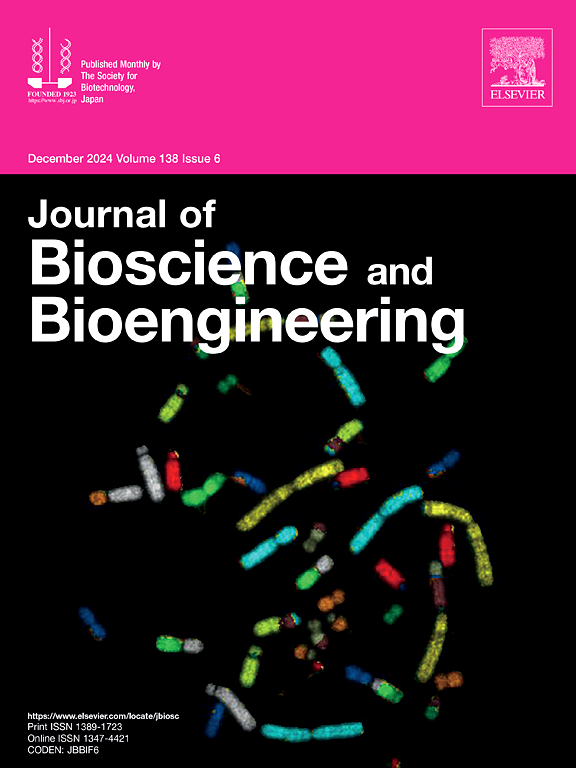Recovery of hyaluronic acid using thermosensitive polymer-salt aqueous biphasic system with polymer recycling
IF 2.9
4区 生物学
Q3 BIOTECHNOLOGY & APPLIED MICROBIOLOGY
引用次数: 0
Abstract
Microbial fermentation emerges as a viable alternative to animal tissue-based extraction for industrial hyaluronic acid (HA) production. However, microbial HA requires rigorous separation and purification processes to meet high purity standards for cosmeceutical use. Aqueous biphasic system (ABS) presents a promising strategy for HA recovery due to its cost-effectiveness, high yield, purity and eco-friendly nature. Thermosensitive polymer, specifically ethylene oxide-propylene oxide (EOPO)-salt ABS, was proposed in the present study to recover microbial HA from Streptococcus zooepidemicus fermentation broth. The effects of molecular weight (MW) of EOPO, types of salt, phase composition, and the amount of crude extract on the efficiency of ABS for HA recovery were studied. Furthermore, the recovery efficiency of ABS formed using recycled EOPO was investigated. HA exhibited a preference for the salt-rich bottom phase of ABS because of its hydrophilic surface features. Highest partition coefficient of 11.41 ± 0.00 and yield of 93.42 % ± 0.00 % were achieved in ABS containing 14 % (w/w) EOPO2500, 12 % (w/w) sodium citrate at pH 8.2 and 15 % (w/w) crude extract. More than 70 % of EOPO2500 was recovered through the thermo-separation process, and the 1st recycling of EOPO2500 maintained a recovery yield of HA above 80 % in ABS. Moreover, Fourier transform infrared spectroscopy validated that HA retained its structure after the recovery process. In conclusion, this study demonstrates the effectiveness of EOPO-salt ABS for microbial HA recovery, achieving high recovery yield. The recycling of EOPO enhances the economic viability and environmental sustainability of the system. These findings pave the way for greener, scalable HA production practices while maintaining product integrity.
热敏聚合物-盐双水相体系回收透明质酸的研究。
微生物发酵作为一种可行的替代动物组织为基础的提取工业透明质酸(HA)生产。然而,微生物透明质酸需要严格的分离和纯化过程,以满足药妆使用的高纯度标准。双相水相体系(ABS)具有成本效益高、收率高、纯度高、环境友好等优点,是一种很有前途的HA回收方法。本研究提出了一种热敏聚合物,即环氧乙烷-环氧丙烷(EOPO)-盐ABS,用于回收动物流行病链球菌发酵液中的微生物HA。研究了EOPO分子量、盐种类、物相组成、粗提物用量等因素对ABS回收HA效率的影响。此外,还研究了回收EOPO形成ABS的回收效率。由于ABS的亲水表面特征,HA表现出对富盐底相的偏好。在含有14% (w/w) EOPO2500、12% (w/w)柠檬酸钠和15% (w/w)粗提物的ABS中,分配系数最高,为11.41±0.00,产率为93.42%±0.00 %。通过热分离工艺回收了70%以上的EOPO2500,第一次回收的EOPO2500在ABS中保持了80%以上的HA回收率,并且傅里叶变换红外光谱验证了回收过程后HA保持了原有的结构。综上所述,本研究验证了eopo盐ABS对微生物HA回收的有效性,实现了较高的回收率。EOPO的回收利用提高了系统的经济可行性和环境可持续性。这些发现为更环保、可扩展的高可用性生产实践铺平了道路,同时保持了产品的完整性。
本文章由计算机程序翻译,如有差异,请以英文原文为准。
求助全文
约1分钟内获得全文
求助全文
来源期刊

Journal of bioscience and bioengineering
生物-生物工程与应用微生物
CiteScore
5.90
自引率
3.60%
发文量
144
审稿时长
51 days
期刊介绍:
The Journal of Bioscience and Bioengineering is a research journal publishing original full-length research papers, reviews, and Letters to the Editor. The Journal is devoted to the advancement and dissemination of knowledge concerning fermentation technology, biochemical engineering, food technology and microbiology.
 求助内容:
求助内容: 应助结果提醒方式:
应助结果提醒方式:


